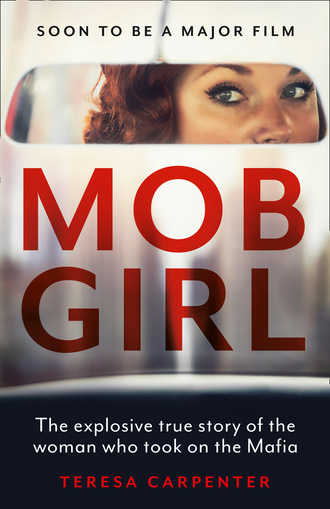
Mob Girl
In the center of the room stood a double bed with a headboard of dark wood carved as expansive, curving arms. Unlike the other beds in the house, it was never covered by a quilt, only a blanket. Arlyne found this strangely out of character with her grandmother’s taste. When she’d satisfied herself that there was no one outside the door, she would lift a corner of the mattress and from one of the coils withdraw a large white handkerchief knotted in the middle. Untying it, she released a small fortune in bills, between two thousand and five thousand dollars. Grandmother’s pin money.
For as long as she dared, Arlyne sat at the foot of the bed, fingering the bills, creasing them, rolling them, counting them, delirious. It was the beginning of her lifelong love affair with money, from which, she perceived at eleven, all things desirable flowed. Money bought the glow of an antique fireplace and emerald bracelets. Money bought cleanliness and safety. It bought power and position, assuring that one would never be mistaken for one of the poor Jews of Hester Street smelling of sweat and pickles. It was money that sustained the rich and highly unorthodox lifestyle of Grandmother Ida Blum.
From the kitchen came the seductive sound of laughter. Arlyne would put the bills back in their hiding place and join the revelers. Entering the open door she encountered a long table laden with a tureen of mushroom and barley soup and covered dishes of pot roast and carrots. Family wandered in and out filling their plates as they pleased. At the far end of the table, bent over the stove, Ida stood resplendent in a sheer blouse and tight skirt. Her platinum hair was twisted into an immaculate bun. On her left hand was a large diamond and ruby ring. On her right, an Eastern Star Ring. Her fingers were covered with matzoh meal.
Spotting her granddaughter, Ida wiped her hands, revealing a set of long and perfect vermilion nails. Then she raised them in a welcoming gesture. Arlyne ran to hug her grandmother around the waist. Ida would not return the hug. (She was not a cuddly bubba.) But the way she said “Dahhhhhling!” left her granddaughter limp with delight. It signified that at that moment she merited the great woman’s entire attention. As Ida turned back to her cooking, Arlyne watched with admiration. She was not a beautiful woman in the conventional sense. Her nose was too broad and her lips too narrow. Throughout most of her life she carried too much weight in her hips. But she transformed the initial impression of awkwardness by force of will. Her posture was always perfect, her diction flawless. Yet underlying that composure was a frank earthiness that men found appealing. The Grandmother, Arlyne observed, was always surrounded by men, most considerably younger than herself.
Among those tummlers who hung around Ida’s kitchen on a Friday night were the chauffeurs, Jimmy and Jake, who drove the hearses in the funeral processions. Both young men were clearly fond of their benefactress. Jake, a ladies’ man, would engage Ida in good-natured teasing and go on his way. The other, however, was more seriously smitten. Jimmy the Gentile, as he was called, was a timid soul who could never seem to find a girlfriend. Ida had taken pity on him and had offered to teach him to dance. Later, when her duties as cook were complete, she would take him by the hand and lead him to the living room where she would put a record on a phonograph. Then, to the delight of onlookers, she would initiate Jimmy into the erotic delights of the tango. Their bodies did not mesh perfectly; Ida overwhelmed her slender partner. But Jimmy was an avid pupil and Arlyne found it exciting to watch their silhouettes against the fire.
Jimmy waited on Ida in mute adoration. Every Saturday night, he drove her to the Roseland Ballroom where she competed in dance contests. Summers and holidays, he drove her to the Concord Hotel, a Jewish resort in the Catskills where she flirted with the dance instructors. He waited and waited. His vigil came to nothing. Ida already had a boyfriend who had staked a firmer claim upon her affections.
Uncle Frankie Oxman had been around as long as anyone could remember. He was a short, rotund man with a jovial disposition. On Friday nights Frankie circulated throughout the funeral parlor dispensing goodwill. The children were fond of him because he had a habit of handing out dollar bills, a princely sum in those days. He was indulgent, buying each of the cousins a duck for the pond. Frankie himself kept pigeons in the tiny backyard and he had an Irish setter upon whom he doted. Every afternoon he and Ida, she decked out in diamonds and an ermine stole, would strut down East Broadway walking the dog. They seemed improbable lovers and their affair was one that Billie and The Aunts were reluctant to acknowledge. Even years later when Frankie died one afternoon of a heart attack in Ida’s bed, The Aunts told themselves he had gone there for a “nap.” This delicacy was due in part to the fact that Ida’s husband, Jacob Blum, was still alive and living in exile somewhere in Brooklyn.
Arlyne remembered her grandfather as a sober, white-haired little man who always wore a black morning coat. Over the years she was to learn very little about his departure. Indeed, the facts of Jacob and Ida’s entire marital history were obscure and Arlyne could never discern whether this was a product of her family’s faulty collective memory or a deliberate amnesia in deference to Frankie Oxman’s position in the household.
Ida’s maiden name, Arlyne knew, was Lasker, and she had come to America as a child with her parents from a region in Poland then under the control of Austria. The family went into the grocery business and became moderately prosperous. Ida was betrothed at the age of sixteen to Jake Blum, who, it was assumed, had a good head for business and could take over the store. Jake, however, had ideas of his own and it was to the general consternation of the Laskers that he abandoned the family enterprise to become an undertaker. He reasoned, quite soundly, that the grocery business was subject to the vagaries of seasons and suppliers, while death produced an enduring clientele. No one was more distressed by Jake Blum’s defection than his young wife, who was revolted by the prospect of sharing a house with corpses. Ida loved life and funerals depressed her. Still, she tried to be a good helpmate. Even if she had no acquaintance with the deceased, she could be found weeping copiously at graveside. Her ostentatious displays of compassion won Jake the business of over a hundred of the funeral societies that had sprung up around the turn of the century to assure that immigrants would be buried, if not with pomp, then at least with a measure of dignity.
The Blums had three children. It was Ida’s destiny to bury two of them. Emmanuel died at the age of thirteen of a burst appendix. Harriet succumbed in early adulthood to pneumonia. Each time, Ida sank into depression. And, as having to endure her grief in the funeral home was intolerable to her, she would pack her bags and move to the Concord. After several months of dancing and merrymaking, she returned to East Broadway, her equilibrium restored.
On her remaining daughter, Ida lavished her undivided attention. Sylvia, a slender, dark girl with rather hawkish features, inherited her mother’s zest for living. Having taken dancing lessons from the time she was a toddler, she aimed for a career on the stage. At the age of fourteen, she secured a place in the chorus line of a troupe called the Manhattan Steppers, who were about to embark on a national tour. Jake Blum objected, his sense of propriety offended by the prospect of his daughter showing her ankles in dance halls around the country. Ida, however, overrode her husband’s objections, saying, “Let her have her fun.” Sylvia spent over six months traveling with the troupe under the stage name of “Billie Young.” She was known forever after as Billie.
In later years, Arlyne read her mother’s letters from the road—sweet, chaste letters that were no doubt intended to put Jake Blum’s worries to rest. She had them pegged as not-so-artful deception. She was sure that her mother had enjoyed what might then have been termed a “fling.” Even as a child, Arlyne was the skeptical sort who had limited tolerance for the little lies that families tell to save face. But, at the age of eleven, she found herself increasingly perturbed by the story of her grandfather’s disappearance.
If you listened to The Aunts—and Arlyne did a good deal of eavesdropping from various vantage points throughout the funeral parlor—Grandfather Blum had met another woman, also an undertaker, at a society meeting and had run off with her. Arlyne, who considered her grandmother the most desirable of all women, found this scenario wholly incredible. The truth, she suspected, was that The Grandfather had been cast out. Jacob Blum was a decent man with few enemies and it was difficult to imagine who might have engineered his downfall. Arlyne’s youthful suspicion, however, fell upon Frankie Oxman.
As good as Frankie was in many respects, Arlyne never fully trusted him. There was something too eager, too opportunistic in his effusive goodwill. He had originally come to work for the Blums as a chauffeur but had seized upon every opportunity to run errands for Ida, collecting corpses from the Kings’ County Mortuary and the “crazy house” out at Pilgrim State, thereby making himself indispensable to her.
Uncle Frankie was always into something shady, which enhanced his stature around the funeral home. No matter what it was you needed, Frankie could get it for you. Pots and pans, bolts of cloth, appliances. When the miraculous phenomenon of television was scarcely rumored in households on the Lower East Side, Frankie got his hands on one of the first models, an RCA with a tiny round screen in an enormous console. Ida was so thrilled with this acquisition that she invited a throng of family and friends into the living room, where she allowed her visitors the rare privilege of sitting on the brocade couches.
But Uncle Frankie’s talents did not end at procuring desirable and presumably purloined commodities. He was also a bookmaker. Long before Jacob Blum went into exile, the chauffeur was taking bets from the neighborhood boys. He kept his money, it was rumored, in one of the caskets. (Arlyne would have happily canvassed those crypts one by one looking for Frankie’s fabled stash, but the lids were heavy and resisted prying.)
After Grandfather Blum’s unexplained departure, Frankie abandoned discretion and brought his bookmaking operation out into the open, headquartering it in a small basement compartment next to the funeral parlor. Throughout most of the morning and early afternoon, a stream of men dressed in suits and fedoras entered and exited by a shallow cement stair from the street. The Clinton Street Boys, as they were known, were small-time racketeers who belonged to a social club a couple of doors down from Blums’. The Boys were a shiftless, fun-loving lot who spent the days playing pool, cards and baseball. Ida courted their goodwill by sponsoring the team, even providing uniforms. They were all avid gamblers and Frankie took their bets.
Sometimes, Arlyne visited her grandmother on Saturday afternoons, preferable to other days because there were no funerals in progress and she could play on the stairs. On those occasions, she would descend a back stairway that led to the basement compartment next door and pay a visit to Uncle Frankie and his friends. She would find them lounging on a pair of old sofas, reading the racing form and listening to an old floor-standing radio for race results. They didn’t seem to mind a child in their midst. Frankie or one of the others might slip her a quarter and pat her cheek. Indeed, for as long as she could remember these men had been “The Uncles.” There was Uncle Milty Tillinger, the shylock. Once when one of Milty’s relatives was on the run from the law, Ida had hidden him in the casket room until the heat was off, incurring the Tillinger family’s loyalty for life. There was Izzy Smith, proprietor of Zion Memorial down the block. Like Frankie a purveyor of hot merchandise, he customarily left his own establishment at midday to place a bet.
The Clinton Street Boys also counted among their number a substantial number of union officials. Now and then one of these men would take Frankie aside and whisper something in his ear. Giving a nod, Frankie would lead the petitioner up the stair to his private office, which was located next to the chapel behind a high brass door. High on the door was a tiny square window with a curtain hung from the inside. When that curtain was pulled, it meant that secret business was being discussed. Arlyne often climbed the stair and, under the guise of playing in the hallway, furtively studied the door. It was taller than any other she had seen. Except for a large, rounded copper knob, it was perfectly plain. The surface was polished daily by the industrious Lily Higgins and it shone like an amber mirror. Arlyne would stare at it, hoping to see through it. But all that came back was her own dark, frustrated face.
The imposing portal with its impenetrable curtain was an affront, since every other door in the funeral parlor was left open, a reflection of Ida Blum’s free, abundant nature. And Arlyne, whose talents for prying were already admirably developed, was galled by the existence of the one enclave to which she was denied access. She was always alert to those few seconds when the door was open admitting Frankie’s visitors. If she was quick, she could catch a peek at the interior of the forbidden compartment.
What she saw was a disappointingly ordinary pair of rooms. In front was a small office with desk and telephone. Behind it was an antechamber with several wooden file cabinets and a large cast-iron safe. One afternoon the opportunity arose to inspect these rooms more closely when Frankie hurried out of his office, inadvertently leaving the door ajar. Arlyne, who had been playing in the chapel, looked down the hall and could not believe her good fortune. Fearful that this lapse signified Frankie’s momentary return, she ambled idly down the hall until she arrived at the office door. Several minutes passed. Frankie was nowhere in sight. Emboldened, Arlyne pushed the door wider and slipped inside. From the front room, she could see that the safe had also been left open. As she moved closer to it she saw that it contained a stack of bound books. The temptation to touch them was irresistible. She knelt by the opening and picking up one of the volumes opened it to a page at random. It contained columns of figures whose significance she could not understand. She studied them fiercely but they remained as impenetrable as the polished surface of the brass door. Then she heard Frankie Oxman’s voice in the vestibule and his heavy tread on the stair. She snapped the book shut, careful to return it to the place she had found it, then scampered out the doorway into the safety of the chapel.
The mystery surrounding Uncle Frankie’s business dealings, and more particularly his presumed role in the departure of Jake Blum, was to nag Arlyne Weiss throughout her remaining childhood years. The answer to this riddle did not come in any sudden revelation, but rather with the slowly evolving awareness of who tugged the strings of the players at Blum’s chapel. From the time Arlyne was about eight, she had noticed among the visitors to Frankie’s office a very tall man with heavy bags under his eyes, his face in a perpetual scowl. “Uncle Red,” as she was instructed to call him, never stopped to joke with her or give her money like the other uncles. He would make a brief weekly visit to Frankie, pay his respects to Ida, then leave. Arlyne could tell from the way Frankie fluttered and fawned in Red’s presence that he was a dangerous man, the term “dangerous” connoting then, as it would for the remainder of her life, the ability to command respect, and more generally to get things done.
Red Levine, she learned as time went on, was a close friend of Meyer Lansky, a soft-spoken Polish immigrant who was already a legend on the Lower East Side. Shortly after his arrival in America in 1911, at the age of nine, he embarked upon a career as a street gambler, and in the years to come he succeeded in forging a criminal empire of gambling, rum running and protection. Castigated as a pariah by Orthodox religious leaders, he was, nonetheless, regarded with admiration, even awe, throughout the Jewish quarter, where he was considered a local-boy-made-good. “Meyer,” as he was called familiarly, enjoyed the status of statesman by virtue of having forged an alliance with the East Side Italian gangs, headed by Charles Lucania—later “Lucky” Luciano.
Luciano and Lansky were later joined by an irascible Jewish hood named Louis Buchalter, also know as “Lepke,” and they came to be referred to collectively as Lucky, Lansky and Lepke. While Luciano and Lepke mingled with showgirls and even socialites, Lansky—the reputed brains of the operation—remained in the background reading books on management. Throughout his fifty-year career he displayed an uncanny instinct for predicting which aspects of American life might be ripe for exploitation. During Prohibition, he brought his gang full-tilt into rum running. Even before the repeal of the Volstead Act in 1933 restored the flow of legal booze, Lansky had his eye on the next field of opportunity: the unions.
The early days of the labor movement were chaotic and violent, particularly in the “rag trade,” whose workers, largely poor immigrants, were crammed into sweatshops and forced to work under deplorable conditions on the Lower East Side. Even after the Garment District moved north into more hospitable accommodations on Seventh Avenue, dissatisfaction grew. Management threatened violence to workers disposed to organize: The unions threatened violence to those who were not. Both sides hired thugs, often professional hoodlums, to enforce their threats. In some cases, the hood was simply a hired gun who would work for whichever side paid most, sometimes working for both. (Others, like Dopey Benny Fein, felt the tug of principle and would break legs only under the union banner.) At first the racketeers merely demanded extortionary rates for their services, which included burning or bombing shops that refused to toe the union line. Soon, however, they moved into more sophisticated applications of terror, demanding and receiving leadership positions. Organizations like the ILGWU were so disrupted by strikes and infighting that “Little Augie” Orgen, a gunman originally hired to protect workers, simply walked in and took over, ushering in the era of the union racketeer.
Recognizing that the unions were fertile territory, Lansky went into business with his old friend Lepke who, as a former protégé of Little Augie, had managed to gain control of trucking in the Garment District. This he did with the help of a squad of thugs commanded by a muscleman named Jake “Gurrah” Shapiro. Lepke and Gurrah, who came to be known as “L&G” or simply “The Boys,” called the shots on Seventh Avenue, where literally no business could be conducted without their approval. Many a legitimate businessman was convinced to make “L&G” silent partners in exchange for assurances that his cargo would be delivered on time. Those who declined were threatened with sabotage and often death. Lansky and The Boys conducted their criminal enterprises virtually unmolested until 1933, when they found themselves drawn into a riptide of politics.
President Franklin Delano Roosevelt, who emerged victorious from the 1932 Democratic National Convention with support from political bosses under Lansky’s control, promptly turned on his old allies, launching an all-out war on organized crime. That move proved so popular that local politicians all over the country took up the standard. The governor of New York, Herbert Lehman, appointed a young and politically ambitious special prosecutor named Thomas Dewey to bring the racketeers to justice. Dewey swung into action with fervor, targeting hoodlums across the spectrum of suspect industries. The brunt of his prosecutorial fury, however, fell upon Lepke and Gurrah, whom he called “the two greatest racketeers in the country.” Realizing the indictments were imminent, The Boys went into hiding for nearly a year, all the while the subjects of an intensive national manhunt. At length, hoping for clemency, they gave themselves up. For Gurrah, the gamble paid off. He was convicted of extortion and got a three-year prison term. Lepke was not so lucky. Federal and state prosecutors both went after him and when they were through he was sentenced to life at Leavenworth.
Lepke’s problems grew worse. In the months after he turned himself in, New York police arrested Abe Reles, a Lansky gunman whom they suspected of several murders. Threatened with the prospect of electrocution, Reles turned state’s evidence and reeled off a string of crimes committed by the Lansky crew over two decades. Among these was the murder of a trucker who had been cooperating with the Dewey investigation. Reles had killed the man, he said, at Lepke’s command. Reles’s confession set in motion a new round of prosecution, which eventually sent Lepke to the electric chair.
The damage of which Reles was capable did not stop there. Reles had knowledge that also threatened to convict Lansky’s lieutenant, Bugsy Siegel. Then, one night as he was being held in protective custody at the Half Moon Hotel in Coney Island, Abe Reles went flying out the window to his death. The question of exactly how a man might be murdered under the watchful eye of six New York City policemen gave rise to a number of theories. Perhaps he hadn’t been murdered at all. Perhaps Reles had repented of his confession, or more likely, realized his life wasn’t worth a plugged nickel, and took an honorable leap. Perhaps someone paid the cops to turn a blind eye, giving safe passage to an assassin. The mystery lingered long after his death.
Arlyne had been only three years old when Abie, as he was known to the Clinton Street Boys, went sailing out the window. As her impression of death was rather imperfectly formed, she never imagined him spreadeagled on the pavement, but rather lying in a coffin, rouged and serene like the other corpses at the funeral home. She had only the most general notion of what his sin might have been. But even a child could see that telling tales on your friends could have dangerous consequences. For each rat, there was an avenging demon. And the identity of Abie Reles’s personal demon was widely debated among The Uncles in Ida Blum’s basement parlor. One candidate was Bugsy Siegel’s right-hand man, Frank Costello, who was rumored to have bribed the police. But those intimately acquainted with the players—and Clinton Street Boys prided themselves on those connections—insisted that the killer was none other than Red Levine.
Arlyne Weiss had no reason to doubt that what The Uncles said was true. The lowering figure who made weekly visits to Frankie Oxman struck her as a menacing presence. It was only after several years of eavesdropping from the stairwell that Arlyne understood what business had originally brought him to Blum’s. During the early forties, there had been a movement afoot on the Lower East Side to unionize the chauffeurs and hearse drivers at funeral parlors. Grandfather Jacob Blum had wanted no part of it, insisting he paid his drivers a fair wage. Jake didn’t want to go into the union out of respect for the old man and Jimmy would go along with whatever Jake did. In the face of this intransigence, the chauffeur’s union had dispatched Red Levine to the Blum funeral parlor hoping he could make Jacob Blum see reason. In short, Uncle Red had threatened to bomb the place, and Jacob Blum, who did not have the stomach for this kind of fight, had given in to the union. With that, all of the other funeral parlors on the Lower East Side followed suit.
The showdown with Red Levine broke Jake Blum’s spirit. After that, he did not manage his business or personal affairs with the rigor that he had used to. Into the vacuum stepped Frankie Oxman, the only one of the Blum chauffeurs who had welcomed the union. He became Red’s boy on the scene, taking over more of the day-to-day running of the business. Gradually he usurped more and more of Jacob Blum’s domain, including his wife. For years Frankie had courted Ida through obsequious errands but now that his star was on the rise, he became bolder. Just when her grandmother and Frankie Oxman became lovers, Arlyne never knew. It had to have occurred, she figured, when she was between the ages of eight (the year Red Levine appeared) and ten (the year Grandfather Blum disappeared). And it had to have occurred under the nose of her mother and the others as they appeared without fail for their Friday night get-togethers. Finally, Jake Blum had packed his bags and walked out the door. It was Arlyne’s conviction that Ida, weary of Jake Blum’s lugubrious presence, flattered by the attention of Frankie Oxman and the seductive prospect of becoming patroness to a crew of racketeers, had thrown her husband out. In time, Ida took Frankie in as a partner. She hauled down the old canopy and hoisted a new one, which read, “Blum and Oxman,” thus announcing to the world that she had decided to live the East Side Life.











